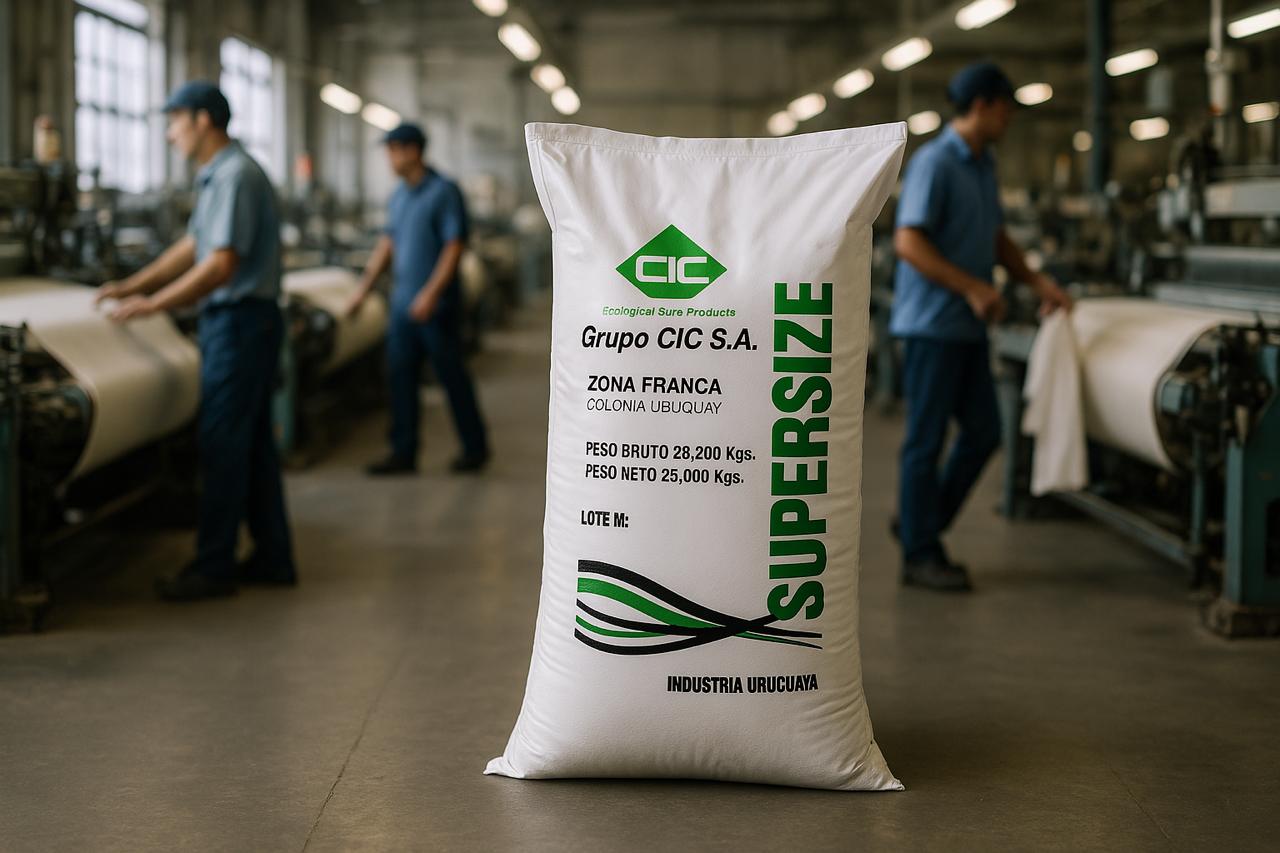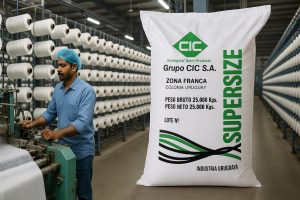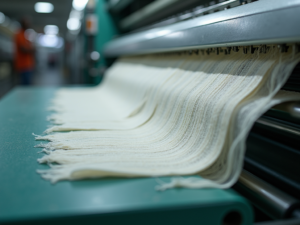The textile industry faces increasing pressure to balance operational efficiency with environmental responsibility. In this landscape, Supersize emerges as a transformative solution for cotton yarn sizing, combining six decades of chemical engineering expertise with cutting-edge ecological innovation. Developed by Cassis International and distributed exclusively in India by Amchem India, this GOTS-certified sizing compound redefines modern textile processing by slashing costs by 30%, eliminating toxic byproducts, and achieving 98% weaving efficiency on high-speed looms. This analysis explores how Supersize’s unique formulation addresses every critical challenge in yarn sizing while aligning with global sustainability mandates.
The Evolution of Sizing Chemicals in Textile Manufacturing
Historical Challenges in Cotton Yarn Sizing
Traditional sizing methods required complex cocktails of polyvinyl alcohol (PVA), carboxymethyl cellulose (CMC), acrylics, and waxes – each introducing compounding costs and environmental liabilities. These multi-component systems demanded precise mixing ratios, extensive storage space, and generated significant waste during process interruptions. The 2024 Textile Sustainability Report revealed that conventional sizing chemicals account for 17% of textile mills’ water pollution loads due to non-biodegradable additives.
The Shift Toward Organic Sizing Chemicals
Global Organic Textile Standard (GOTS) certification has become the benchmark for eco-conscious textile production, with demand growing 34% annually in India alone. Supersize meets this demand through its plant-derived formulation containing esterified gels, emulsion oils, and antistatic agents that achieve 93.3% biodegradation within standard wastewater treatment cycles. Unlike conventional options, it contains zero persistent organic pollutants (POPs) or bioaccumulative toxins, as verified by Daphnia magna toxicity testing.
Technical Superiority of Supersize in Cotton Processing
Optimized Physicochemical Properties
Supersize’s non-ionic to lightly anionic character (pH 6.5) ensures compatibility with all starch types – corn, tapioca, potato, or rice. Its unique viscosity profile (8 sec via Zhan Cup #3 at 90°C) remains stable throughout sizing operations, preventing the 12-15% viscosity drop characteristic of PVA blends. The compound’s 6.46% moisture content by Karl Fischer testing enhances shelf stability, eliminating the 8-10% material loss from clumping seen in hygroscopic sizing agents.
Operational Efficiency Enhancements
Mills using Supersize report:
- 70% reduction in storage requirements through high-concentration formulation (25kg bags with 2.5kg sub-packs)
- 83-second dissolution time versus 4-6 minutes for conventional mixes
- 0.08% second-quality yarn production during machine stops versus 2.1% industry average
The product’s thermal stability prevents polymer degradation even during extended downtimes, requiring only reheating to 80-90°C for process resumption.
Economic Advantages for Indian Textile Mills
Cost Analysis: Supersize vs Conventional Systems
A 2024 case study at a Surat-based weaving unit demonstrated:
| Parameter | Supersize System | Conventional System |
|---|---|---|
| Sizing Cost/kg yarn | ₹3.21 | ₹4.89 |
| Loom Stoppages/day | 1.2 | 4.7 |
| Monthly Starch Usage | 12.4 tons | 18.1 tons |
| Annual Waste Treatment | ₹2.8 lakh | ₹9.3 lakh |
Data sourced from Amchem India’s 2024 mill optimization program
Supersize achieves these savings through its 15:1 starch-to-additive ratio – significantly leaner than the 5:1 to 7:1 ratios of older formulations. The elimination of separate antistats, lubricants, and humectants further simplifies inventory management.
Supply Chain Optimization
As the exclusive Indian distributor, Amchem India ensures:
- Pan India delivery with ready stock
- Complimentry first free trial
- Technical support teams fluent in Hindi, English, Gujarati, Tamil, and Punjabi
- Customized formulations for specific loom types (rapier, airjet, projectile)
Environmental Compliance and GOTS Certification
Biodegradation Performance
Third-party testing confirms Supersize’s environmental credentials:
- BOD5: 135 mg/L (vs 250 mg/L limit under CPCB norms)
- COD: 1.03 g/L (83% below textile effluent standards)
- 96-hour LC50: >1000 mg/L (classified as practically non-toxic)
The product’s oxygen demand profile allows conventional activated sludge systems to achieve 93.3% degradation within 72 hours, making it ideal for ZLD (Zero Liquid Discharge) facilities.
GOTS Certification Process
Cassis International’s CU 813028 certification involves:
- Annual audits of raw material sourcing (non-GMO plant derivatives)
- Batch testing for heavy metals (Pb <0.001%, Cd <0.0005%)
- Supply chain transparency from Uruguay production facilities to Indian distribution points
Implementation Strategies for Indian Mills
Transitioning from Conventional Systems
Amchem’s technical team recommends:
- Phase 1: Parallel processing with 30% Supersize substitution
- Phase 2: Optimization of starch levels (+8-12% concentration)
- Phase 3: Full integration with viscosity adjustment
Mills typically achieve ROI within 14 weeks through:
- 28-34% reduction in sizing costs
- 15-22% lower steam consumption
- 40-60% decrease in sizing-related machine maintenance
Troubleshooting Common Challenges
- High Humidity Environments: Utilize Supersize’s inherent 0.2% ash content to prevent moisture absorption
- Mixed Fiber Blends: Adjust starch ratio up to 1:18 for polyester-cotton mixes
- High-Speed Looms: Implement 6.5-15 lb starch loads for optimal abrasion resistance
Future Developments in Organic Sizing Technology
Nanotechnology Integration
Cassis International’s R&D pipeline includes:
- Silica nanoparticle-enhanced formulations for 2400 m/min airjet looms
- pH-responsive viscosity modifiers for automated dosing systems
- Blockchain-tracked biodegradation metrics for ESG reporting
Regulatory Outlook
With India’s revised Bio-Medical Waste Rules (2025) imposing stricter limits on textile chemicals, Supersize’s <0.001% heavy metal content positions it as a future-proof solution. The upcoming BIS 17876 standard for organic sizing agents aligns closely with Supersize’s existing technical specifications.
Conclusion: Supersize as the New Standard
Supersize represents more than a product – it embodies the evolution of textile chemical engineering. By delivering 30% cost savings, 70% storage reduction, and GOTS-compliant operation in a single formulation, it resolves the fundamental dichotomy between economic and environmental performance. For Indian mills facing 2025’s dual challenges of rising cotton prices and stricter pollution norms, adopting Supersize through Amchem India’s certified supply network offers a strategic pathway to sustainable competitiveness.
As the textile sector transitions toward circular economy models, Supersize’s 93.3% biodegradability and resource-efficient design provide a blueprint for next-generation processing aids. With sixty years of continuous innovation and Amchem’s localized technical support, this solution empowers Indian manufacturers to lead the global shift toward responsible textile production. Contact us for trials and quotes today!




